Walgreens

Walgreens

 A Walgreens store in Steamboat Springs, Colorado. | |
Trade name | Walgreens |
|---|---|
Type | Subsidiary |
| Industry | Retail |
| Founded | 1901 (1901) Chicago, Illinois, U.S. |
| Founder | Charles Rudolph Walgreen |
| Headquarters | 200 Wilmot Road, Deerfield, Illinois , |
Number of locations | 9,560[1] |
Area served | United States Puerto Rico U.S. Virgin Islands |
Key people | James A. Skinner (Executive Chairman) Alex Gourlay (President) Stefano Pessina (CEO) |
| Products |
|
| Parent | Walgreens Boots Alliance (2014–present) |
| Website | walgreens.com [92] |
| Footnotes / references [2] | |
Walgreen Company or simply Walgreens is an American company that operates as the second-largest pharmacy store chain in the United States behind CVS Health.[3] It specializes in filling prescriptions, health and wellness products, health information, and photo services.[4] As of August 31, 2018, the company operated 9,560 stores in all 50 states, the District of Columbia, Puerto Rico and the U.S. Virgin Islands. It was founded in Chicago, Illinois, in 1901. The Walgreens headquarters office is in the Chicago suburb of Deerfield, Illinois.
In 2014 the company agreed to purchase the remaining 55% of Switzerland-based Alliance Boots that it did not already own to form a global business. Under the terms of the purchase, the two companies merged to form a new holding company, Walgreens Boots Alliance Inc., on December 31, 2014. Walgreens became a subsidiary of the new company, which retains its Deerfield headquarters and trades on the Nasdaq under the symbol WBA [93] .[5]
 A Walgreens store in Steamboat Springs, Colorado. | |
Trade name | Walgreens |
|---|---|
Type | Subsidiary |
| Industry | Retail |
| Founded | 1901 (1901) Chicago, Illinois, U.S. |
| Founder | Charles Rudolph Walgreen |
| Headquarters | 200 Wilmot Road, Deerfield, Illinois , |
Number of locations | 9,560[1] |
Area served | United States Puerto Rico U.S. Virgin Islands |
Key people | James A. Skinner (Executive Chairman) Alex Gourlay (President) Stefano Pessina (CEO) |
| Products |
|
| Parent | Walgreens Boots Alliance (2014–present) |
| Website | walgreens.com [92] |
| Footnotes / references [2] | |
History
Company history
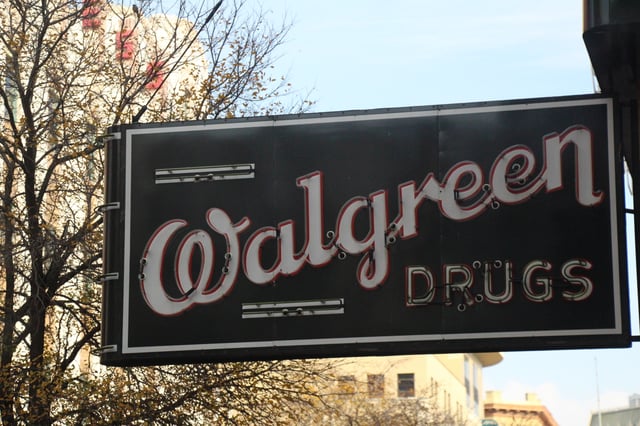
Early "Walgreen Drugs" sign still in use in San Antonio, Texas
Walgreens began in 1901, with a small food front store on the corner of Bowen and Cottage Grove Avenues in Chicago, owned by Galesburg native Charles R. Walgreen.[6] By 1913, Walgreens had grown to four stores on Chicago's South Side. It opened its fifth in 1915, and four more in 1916. By 1919, there were 20 stores in the chain. As a result of alcohol prohibition, the 1920s were a successful time for Walgreens. Although alcohol was illegal, prescription whiskey was available and sold by Walgreens.[7]
In 1922 the company introduced a malted milkshake, which led to its establishing ice cream manufacturing plants. The next year, Walgreen began opening stores away from residential areas. In the mid-1920s, there were 44 stores with annual sales of $1,200,000 combined. Walgreens had also expanded by then into Minnesota, Missouri, and Wisconsin.
By 1930 it had 397 stores with annual sales of US$4,000,000. This expansion partly was attributed to selling prescribed alcohol, mainly whiskey, which Walgreen often stocked under the counter, as accounted in Daniel Okrent's Last Call: The Rise and Fall of Prohibition.[8] The stock market crash in October 1929 and the subsequent Great Depression did not greatly affect the company. By 1934, Walgreens was operating in 30 states with 601 stores.
After Charles Walgreen, Sr., died in 1939, his son Charles R. Walgreen, Jr. took over the chain until his retirement. The Charles R. Walgreen's (Walgreen Jr.) years were relatively prosperous, but lacked the massive expansion seen in the early part of the century. Charles "Cork" R. Walgreen III took over after Walgreen Jr.'s retirement in the early 1950s and modernized the company by switching to barcode scanning. The Walgreen family was not involved in senior management of the company for a short time following Walgreen III's retirement. In 1986, it acquired the MediMart chain from Stop & Shop.[9] In 1995, Kevin P. Walgreen was made a vice-president and promoted to Senior Vice President - Store Operations in 2006.[10] On July 12, 2006, David Bernauer stepped down as CEO of Walgreens, replaced by company president Jeff Rein. Holding degrees in accounting and pharmacy from the University of Arizona, Rein was a pharmacist, store manager, district manager, and treasurer prior to being named Chief Executive Officer and Chairman of the Board. Greg Wasson, former President of Walgreens Health Services, was named President and Chief Operations Officer.
On October 10, 2008, Rein abruptly quit as CEO, replaced by Alan G. McNally as Chairman and Acting CEO.[11]
On January 26, 2009, Gregory Wasson was named CEO, effective February 1, 2009.[12]
21st-century expansion

A neon-lit store on Canal Street in New Orleans
2006: Walgreens acquired the Happy Harry's chain in Delaware, Pennsylvania, Maryland, and New Jersey.[13]
October 2007: Walgreens opened its 6,000th store, in New Orleans, Louisiana.[14]
January 2008: Walgreens purchased 20 stores in Puerto Rico from Farmacias El Amal.[15]
July 2009: Walgreens operates in all 50 states and the District of Columbia.[16]
February 17, 2010: Walgreens announced plans to acquire New York City-area chain Duane Reade for $1.075 billion, including debt.[17] Walgreens continues to operate in the New York City metropolitan area as Duane Reade; its stores near existing Walgreens were closed.
March 24, 2011: Walgreens acquired Drugstore.com for $409 million. Drugstore.com, in turn, owned Beauty.com. In 2013 Beauty.com was named by Internet Retailer Magazine in its Top 100 online retail sites list.[18][19]
April 30, 2011: Walgreens operated 8,169 stores; it had expanded into Guam and Puerto Rico.[20]
August 18, 2011: Walgreens introduced its "Nice!" store brand of food and household products. Fully rolled out in 2012, the Nice! brand replaced a variety of existing Walgreens store brands such as Deerfield Farms, Cafe W, and others.[21]
June 19, 2012: Walgreens paid $6.7bn for a 45% interest in Alliance Boots.[22]
July 5, 2012: Walgreens entered into an agreement to acquire Mid-South drug store chain operating under the USA Drug, Super D Drug, May's Drug, Med-X, and Drug Warehouse banners. The deal was expected to be finalized by September 1, 2012.[23]
September 10, 2013: Walgreens announced it acquired Kerr Drug.[24]
September 14, 2013: Walgreens opens its first store in the U.S. Virgin Islands.[25]
August 6, 2014: Walgreens exercised its option to purchase the remaining 55% of Alliance Boots. The combined company is known as the Walgreens Boots Alliance and is headquartered in Chicago.[26][27]
On October 27, 2015, Walgreens announced that it would acquire its rival Rite Aid for $9 per share, a deal valued at $9.4 billion, pending regulatory and shareholder approval. The deal will result in a merger of two of the United States' three largest pharmacy chains.[28] In response to being able to receive approval, Walgreens said that it would be willing to divest up to 1,000 stores to win regulatory approval for its Rite Aid purchase.[29] Walgreens and Rite Aid, combined, own approximately 200 million square feet of retail space in addition to 21 million square feet of office and warehouse space. The two chains operate 12,900 stores in the United States. Walgreens operates 13,100 stores across 11 countries. Walgreens CEO has stated that there is potentially over $1 billion in savings to be reaped from the merger through synergies.[30] On December 21, 2016, it was announced that Fred's would acquire 865 Rite Aid stores as a result of the merger for the price of $950 Million USD for antitrust reasons.[31] In January 2017, Walgreens reached a deal to lower the price of the acquisition from $9.4 to $6.8-$7.4 billion and delayed the closing by six months.[32] On June 29, 2017, Walgreens announced that it would drop its original plan to acquire Rite Aid due to resistance from federal regulators, and would instead buy about half of Rite Aid's existing stores for $5.18 billion in cash.[33] Under the terms of the agreement, Walgreens will acquire 2,186 stores, 3 distribution centers, and other Rite Aid inventory.[34] The stores are expected to be converted from Rite Aid stores into Walgreens stores, making Walgreens the largest drug-store chain by number of locations in the U.S. with over 10,200 stores.[35] The company also agreed to pay Rite Aid a $325 million fee for ending the earlier merger agreements.[34] The deal was scrapped on June 29, 2017. On September 19, 2017, the Federal Trade Commission (FTC) approved a fourth deal agreement to purchase Rite Aid with 1,932 stores for $4.38 billion total.[36]
On July 28, 2016, Walgreens announced it would shut down Drugstore.com, as well as Beauty.com, in order to focus on its own Walgreens.com website.[37]
In October 2017, Walgreens announced they would be closing approximately 600 stores in the two years. The stores would be mostly Rite Aid locations and the closings would begin in the spring of 2018.[38]
In January 2018, Walgreens stated that it expects to acquire 1,932 Rite Aid locations by the spring of 2018.[39]
In August 2019, Walgreens announced it would be closing approximately 200 stores.[40]
Contributions to popular culture
Walgreens claims credit for the popularization of the malted milkshake (or at least its version of the malted milkshake), invented by Ivar "Pop" Coulson in 1922,[41] although milkshakes and malted milk had been around for some time before. This development coincided with the invention of the electric blender in the same year.
In November 2010 Walgreens filed a trademark infringement lawsuit against the Wegmans supermarket chain, claiming the "W" in the Wegman's logo is too similar to Walgreens'.[42] The lawsuit was settled in April 2011, with Wegmans agreeing to discontinue use of its "W" logo by June 2012, although the supermarket retains the right to use the "Wegmans" name in script.[43] According to Jo Natale, Wegmans director of media relations, "The cost of making relatively minor changes to a limited number of products was much less than the cost of litigating this case to the end."[44]
The logo for the Washington Nationals baseball team is very similar to the Walgreens "W" (though it dates back to the 1960s iteration of the Washington Senators);[45] to date, Walgreens never challenged the Nationals' use of their "W" in a lawsuit.
Corporate operations
Walgreens has had a technology office located in Chicago since 2010. The location serves as a their digital hub.[49]
In 1987 Walgreens employed about 1,100 people at its headquarters, which was at the time in an unincorporated area on the west side of Deerfield.[50][51] As of 2000, headquarters was still in an unincorporated area in West Deerfield Township.[52]
In summer 2014 a corporate relocation to Switzerland was considered as part of a merger with Alliance Boots, a European drugstore chain.[53] This drew controversy as many consumers felt that it was an attempt at tax inversion. On August 5, 2014, Walgreens announced that they would not be relocating their headquarters.
In spring 2018 Walgreens announced it would relocate about 1,800 jobs, many of them relating to its digital and IT operations, to the newly-renovated Old Chicago Main Post Office.[54]
Walgreens Brands
| Brand | Product |
|---|---|
| Botanics | Skincare |
| Complete Home | Household |
| CYO | Cosmetics |
| Finest Nutrition | Vitamins |
| Infinitive | Electronics |
| Liz Earle | Skincare (UK) |
| Nice! | Groceries |
| No. 7 | Skincare |
| PetShoppe | Pets |
| Sleek MakeUP | Cosmetics |
| Soap & Glory | Cosmetics |
| Soltan | Sunscreen (UK) |
| Well at Walgreens | Healthcare |
| Wexford | Office Supplies |
| YourGoodSkin | Skincare |
Store model
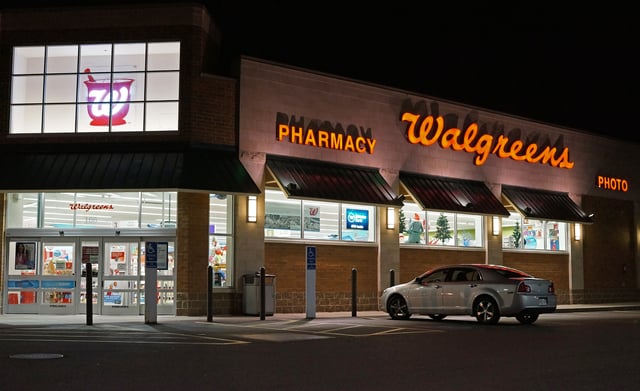
A Walgreens on Rt.1 South, Saugus, Massachusetts
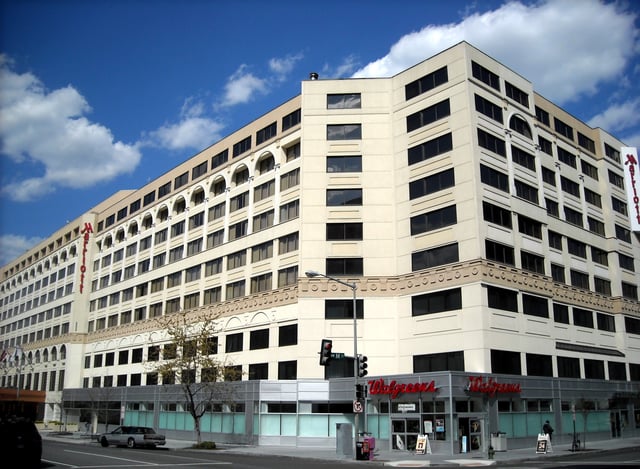
A Walgreens "corner drugstore", located in a Marriott street-level retail space, on the corner of a heavily trafficked intersection in Washington, D.C.
Walgreens stores were once connected to local groceries. In Chicago, their flagship market, they teamed up with either Eagle Food Centers or Dominick's Finer Foods, usually with a "walkthru" to the adjoining store and often sharing personnel. This concept was instated to compete with the popular dual store format used by chief competitor Jewel-Osco/Albertsons-Sav-On. They eventually ended the relationship with Eagle and focused primarily on a connection to the Dominick's stores. PharmX-Rexall filled the vacated Walgreen locations joined to Eagle stores.
In its 2009 business model, Walgreens are freestanding corner stores, with the entrance on the street with the most traffic flow, figuratively making it a "corner drugstore" similar to how many independent pharmacies evolved. Many stores have a drive-through pharmacy.[56]
Most freestanding stores have a similar look and layout, including a bigger and more spacious layout than certain stores within major cities. Newer buildings have a more modern design to them compared to older stores. Stores within major cities, such as New York and Chicago, could have multiple floors. Behind the front registers are tobacco products and alcoholic beverages. However, some stores do not sell these products, such as New Jersey stores not selling alcohol, or Massachusetts stores not selling tobacco.[57] Stores usually have a beauty counter located near the cosmetics, with busier stores having a beauty consultant. All stores have a photo department, which is either behind the front register, or in a separate part of the store. There are self-serve photo kiosks near the photo department, where customers can print photos and photo products. All stores have a pharmacy, usually located in the back, where people drop off and pick up prescriptions, as well as purchase certain drugs containing pseudoephedrine.
Related ventures
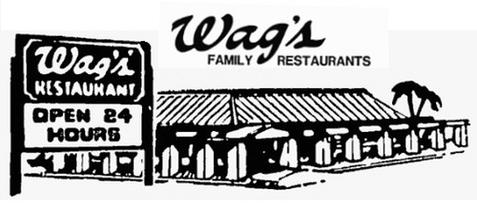
Wag's menu logo circa 1985
In the 1980s Walgreens owned and operated a chain of casual family restaurants/pancake houses called Wag's, an attempt to compete with Woolworth's lunch counters. The Wag's restaurants were very similar in concept to Denny's, IHOP, and Golden Bear. At the highpoint, it had over 100 locations. Walgreens sold most of these to Marriott Corp. in 1988[59] and by 1991, the chain was out of business.
Consumer record
In December 2012, a judge ordered Walgreens to pay $16.57 million to settle a lawsuit claiming that over 600 stores were illegally dumping hazardous waste and unlawfully disposing of customer records containing confidential medical information.[60]
A San Jose, California court in January 2018, allowed Walgreens to pay $2.25 million to resolve a consumer protection lawsuit brought by Bay Area prosecutors alleging that the company sold expired baby food, infant formula and over-the-counter drugs. The suit also alleged that Walgreens violated state law by charging more than the lowest posted or advertised price for items.[61]
Investor relations
In September 2018 Walgreens agreed to pay $34.5 million to settle a U.S. Securities and Exchange Commission (SEC) investigation on charges of misleading investors on financial targets. The SEC alleged that former CEO Greg Wasson and then-CFO Wade Miquelon acted "negligently" in giving financial estimates.[62]
Prescriptions
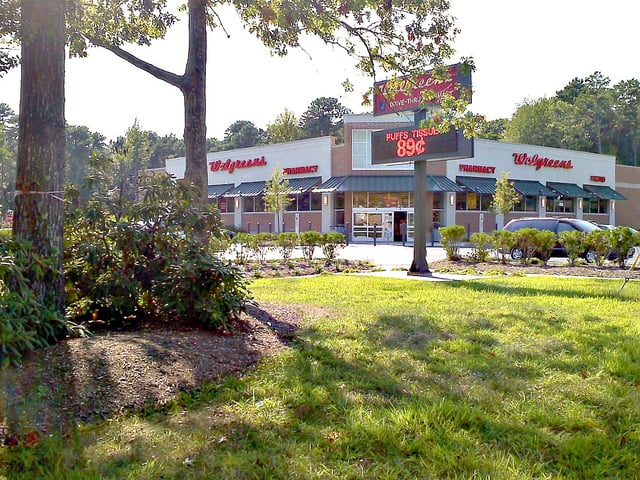
A Walgreens in Little Egg Harbor, New Jersey, which opened in 2006
Walgreens was accused of switching the dosage forms on three medications commonly prescribed for Medicaid patients without doctor approvals in order to boost profits. This resulted in Medicaid programs nationwide paying much more for the medications than they normally would have, according to a press release by the [Tennessee] attorney general's office. Walgreen Co. agreed to comply with state and federal laws on the matter, plus pay $35 million to the federal government, 42 states and the Commonwealth of Puerto Rico.
"The compliance agreement will be in effect for five years. Walgreens did not admit liability, as part of the settlement," reported the Chicago Sun-Times.[65]
The Walgreens website invited users to write reviews of some OTC products such as vitamins and nutritionals but did not invite users to write reviews of the corresponding Walgreens-branded products. A recent revision of the Walgreens website has added the ability to review any product it sells.
Allegations of discrimination
In March 2008 Walgreens settled a lawsuit with the Equal Employment Opportunity Commission (EEOC) that alleged the company discriminated against African Americans for $24 million.[66] The settlement was split between the 10,000 African-American employees of the company.[66] In the agreement, Walgreens avoided any admission of guilt.
The decree, one of the largest monetary settlements in a race case by the EEOC, provides for the payment of over $24 million to a class of thousands of African American workers and orders comprehensive injunctive relief designed to improve the company's promotion and store assignment practices.
In September 2011 Walgreens settled a lawsuit with the Equal Employment Opportunity Commission that claimed that a store improperly terminated a worker with diabetes for eating a package of the store's food while working to stop a hypoglycemia attack.[67]
Medicaid
Also in 2008, Walgreens "agreed to pay $35 million to the U.S. and 42 states and Puerto Rico for overcharging state Medicaid programs by filling prescriptions with more expensive dosage forms of ranitidine, a generic form of Zantac and fluoxetine, which is a generic form of Prozac."[68]
In 2009 Walgreens threatened to leave the Medicaid program, the state and federal partnership to provide health insurance coverage to the poor, in Delaware, over reimbursement rates. Walgreens was the largest pharmacy chain in the state and the only chain to make such a threat.[69] The state of Delaware and Walgreens reached an agreement on payment rates and the crisis was averted.[70]
In 2010 Walgreens stopped accepting Medicaid in Washington state, leaving its one million Medicaid recipients unable to get their prescriptions filled at these 121 stores.[71]
On April 20, 2012, the U.S. [Department of Justice] announced, that Walgreens agreed to pay $7.9 million in settlement. The fine relates to allegations of violations of the federal Anti-Kickback Statute and the False Claims Act regarding beneficiaries of federal health care programs.[72]
January 2019 Walgreens Boots Alliance Inc. agrees to pay more than $269 million to settle federal and state lawsuits that accused it of overbilling federal health-care programs.[73]
Express Scripts
In 2011 Walgreens announced it would end its relationship with Express Scripts,[74] a prescription benefits manager. A coalition of minority groups, led by Al Sharpton's National Action Network,[75] sent letters urging CEO Gregory Wasson to reconsider. Groups sending letters were National Hispanic Christian Leadership Conference,[76] the Congress of Racial Equality,[77] Hispanic Leadership Fund[78] and others. On July 19, 2012, Walgreens and Express Scripts announced a multi-year pharmacy network agreement that includes rates and terms under which Walgreens would participate in the broadest Express Scripts retail pharmacy network available to new and existing clients as of September 15, 2012.
Use of proprietary drugs
Walgreens was named in a lawsuit by the Union Food and Commercial Workers Unions and Employers Midwest Health Benefits Fund in the Northern District Court of Illinois in January 2012. The suit alleges Walgreens and Par Pharmaceutical violated the Racketeer Influenced and Corrupt Organizations Act[79] "at least two widespread schemes to overcharge" for generic drugs.[68]
The lawsuit alleges drugstore chain Walgreen and generic pharmaceutical maker Par established a partnership in which Par manufactured and/or marketed generic versions of antacid Zantac and antidepressant Prozac in dosage forms that weren't subject to private and governmental reimbursement limitations. It further said Walgreen purchased those dosage forms from par at a cost substantially higher than the widely prescribed dosage forms, and then "systematically and unlawfully filled its customers' prescriptions with Par's more expensive products, rather than the inexpensive dosage forms that were prescribed by physicians."
Distribution of oxycodone
In September 2012 the U.S. Drug Enforcement Administration (DEA) accused Walgreens of endangering public safety and barred the company from shipping oxycodone and other controlled drugs from its Jupiter, Florida, distribution center. The DEA said that Walgreens failed to maintain proper controls to ensure it didn't dispense drugs to addicts and drug dealers. The DEA also said that six of Walgreens' Florida pharmacies ordered in excess of a million oxycodone pills a year. In contrast, in 2011 the average pharmacy in the U.S. ordered 73,000 oxycodone tablets a year according to the DEA. One Walgreens pharmacy located in Fort Myers, Florida, ordered 95,800 pills in 2009, but by 2011, this number had jumped to 2.2 million pills in one year. Another example was a Walgreens pharmacy located in Hudson, Fla., a town of 34,000 people near Clearwater, that purchased 2.2 million pills in 2011, the DEA said. Immediate suspension orders are an action taken when the DEA believes a registrant, such as a pharmacy or a doctor, is "an imminent danger to the public safety." All DEA licensees "have an obligation to ensure that medications are getting into the hands of legitimate patients," said Mark Trouville, former DEA special agent in charge of the Miami Field Division. "When they choose to look the other way, patients suffer and drug dealers prosper."
The Jupiter, Florida, distribution center, which opened in 2001, is one of 12 such distribution centers owned by Walgreens. Since 2009, Walgreens' Jupiter facility has been the largest distributor of oxycodone in the state of Florida, the DEA said. Over the past three years, its market share has increased, and 52 Walgreens are among the top 100 oxycodone purchasers in the state, the DEA said.[80]
In 2013 United States Attorney Wifredo Ferrer said Walgreens committed "an unprecedented number" of record-keeping and dispensing violations." Walgreens was fined $80 million, the largest fine in the history of the Controlled Substances Act at that time.[81]
Sale of tobacco
In common with other U.S. pharmacies (a major exception is CVS Pharmacy), Walgreens stocks tobacco products for sale to the public. Some campaigners in the United States advocate the removal of tobacco from pharmacies owing to the health risks associated with smoking and the apparent contradiction of selling cigarettes alongside smoking cessation products and asthma medication.[82] Walgreens and other pharmacies who continue to sell tobacco products have been subject to criticism, and attempts have been made to introduce regional bans on the practice, which has taken place in the City and County of San Francisco.[83][84]
Walgreens defends its tobacco sales policy by reasoning that through selling tobacco in its outlets, it is more readily able to offer to customers advice and products for quitting smoking. As of December 2017, Walgreens changed its slogan from "At the corner of happy and healthy" and "On your way to Well" to "Trusted since 1901".
However in Massachusetts, as of January 1, 2019, pharmacies will be no longer able to sell tobacco and similar products.[57]
Pricing and advertising
The Wisconsin Department of Agriculture, Trade and Consumer Protection fined Walgreens for differences between shelf price and scanned price and for signage in 2012. In 2013, Walgreens paid a $29,241 fine.[85]
The New York State Attorney General announced in April 2016 that a settlement was reached in complaint that Walgreens used misleading advertising and overcharged consumers. Walgreens would pay $500,000 in penalties, fees and costs, and change advertising and other practices.[86]
A judge in Kansas City, Missouri ordered Walgreens to pay a $309,000 fine for pricing discrepancies in 2015.[87]
Medication denied because of religious beliefs
In June 2018 a staff pharmacist at a Walgreens in Peoria, Arizona refused to give a woman medication to end her pregnancy. The medication was prescribed by a doctor, after tests revealed that the pregnancy would end in a miscarriage. The woman said she was left "in tears and humiliated". Walgreens responded that its policy "allows pharmacists to step away from filling a prescription for which they have a moral objection".[88][89]
See also
Corporate inversion
CVS Pharmacy
Rite Aid
Alliance Boots
Walgreen Coast